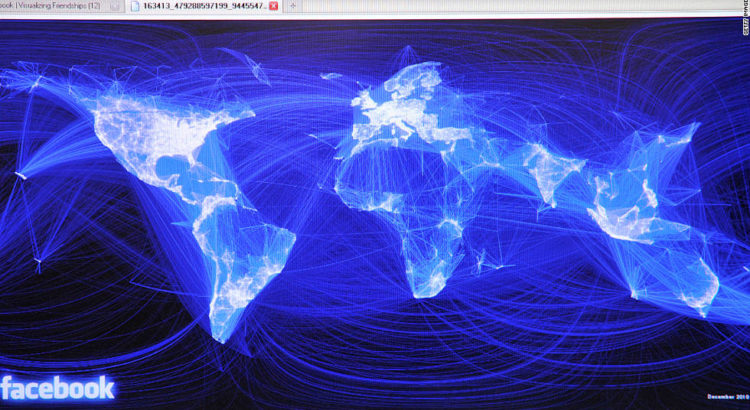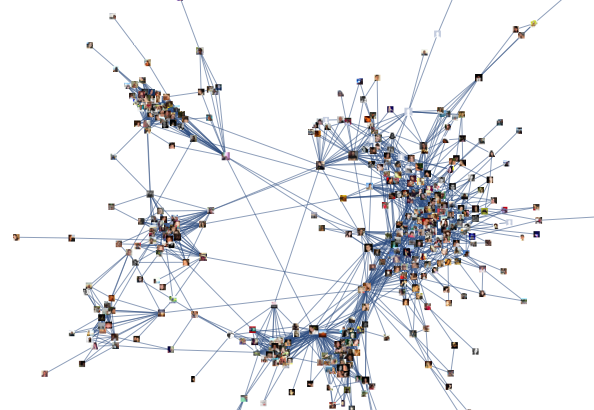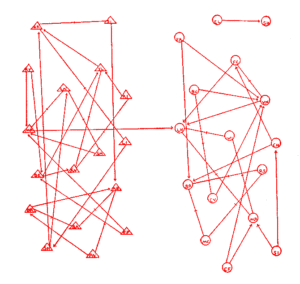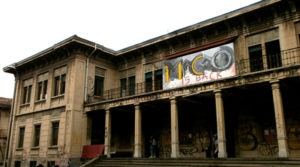(Cover: Fabrice – Muiderpoort Station, Amsterdam 2010, detail. Photo: Giulia May)
In a dystopian present marked by physical isolation, digital platforms are acquiring an even more central role in our private and social lives. They enable us to connect with our loved ones, to look for useful (or misleading) information, rethink our work connections, find online yoga courses, buy goods and share uplifting or emotional contents – in short to live in and feel a system of interconnected close and wider communities.
While the social, cultural and psychological outcomes of these new patterns of interaction with digital media are yet to be seen, just before the beginning of the pandemic era a series of studies were trying to assess the impact of digital platforms on political participation. The International Communication Journal’s last issue of 2019, with its special section dedicated to Platform Politics in Europe, looks like an ideal occasion to try and resume some of the many open questions on digital platforms and their political use – as we try to process other uses in a version heightened by our hyperconnected isolation.
Edited by Marco Deseriis and Davide Vittori, the feature included six case studies on the use of digital platforms in different European contexts and involving various political actors. While the common thread was how each platform makes some degree of political participation possible, one central question remains mostly unanswered, and even unasked: who are the users of these digital platforms, how do they use the platforms, and why in these studies they are almost never given a voice?
1. Digital platforms shaping the “long 2010s”
Social media platforms and digital democracy platforms. The “long 2010s”, as Deseriis and Vittori call them, have been dominated by anti-austerity and anti-authoritarian movements incorporating social media in new and disruptive ways. While the “inner logic” of commercial social networks might have facilitated social movements in their emerging phase, it appeared to be less suited to long-term strategies (van Dijck & Poell, 2013). This is why some groups moved to specialised (and open) software tools for their organisation and decision making, creating new digital democracy platforms. Deseriis and Vittori insist that the communalities between political use of social media platforms (SMPs) and digital democracy platforms (DDPs) are more relevant than their differences. Still, they are significant: SMPs are mainly focused on commodifying user data and extracting profit from this information, although, thanks to their large user base, they have surely contributed to revitalise political action. DDPs, on the other hand, can in principle support democratic participation and deliberation, but they tend to have limited impact and scope.
How is algorithmic logic affecting participation? One important theme in recent debates is how much ‘algorithmic logic’ conditions the agency of Social Media Platform users. On the one end of the spectrum there is the idea (e.g. van Dijk & Hacker, 2018) that an algorithmic logic, replacing the editorial logic of earlier media generations, is more pervasive and shapes users’ participation in subtle ways. At the other end there are those who emphasise users’ creativity and resourcefulness (e.g. Clark et al., 2014), showing how people can play with platform affordances, repurpose features, and circumvent limitations. Another author contributing to the special issue, Maria Bakardjieva, concludes that “citizens’ participation … cannot be reduced to the design of the platforms alone, but it is certainly affected by it”. What makes the difference, she argues, is “Who participates? In what? For what purpose?”.

2. E-government, party and civic platform users
Can a digital platform empower party members? Deseriis and Vittori try to assess the impact of the platforms used by Podemos and 5Stars, respectively “Participa” and “Rousseau”, on internal party democracy and power imbalances. Both parties show a “technopopulist orientation” (Deseriis, 2017), but also strong differences in terms of political and ideological trajectories. These are also reflected by diverging organisational models: a variety of centralised and decentralised decision-making bodies (Podemos) versus no intermediary party bodies at all (5SM). Deseriis and Vittori argue that despite these important differences, in both cases “the affordances of these platforms are often employed selectively” and mostly used to just confirm decisions already taken by the party leaders. This might be one of the reasons for the sharp decline in voter turnout both platforms registered after the first year. Other possible reasons include the drop-out of early adopters or the fact that members are asked to vote too frequently, or – in the case of the 5SM – that when it comes to controversial issues, Rousseau only provides members with their leaders’ viewpoints and no alternatives. New studies would need to confirm these hypotheses, and include extensive feedback from the users of both platforms.
Can a platform preserve the quality of a debate over time? Looking at social media platforms one might be inclined to say no, but digital democracy platforms used by local administrations in Europe have also tried to reshape participation and deliberation. In their study on Decidim, the platform allowing citizens to contribute to Barcelona’s Strategic City Planning, Borge Bravo, Balcells, and Padró-Solanet looked at “the deliberative quality” of the debate on tourism and hospitality in the city. What emerges from their analysis is that time is a key factor, as conversations on platforms like Decidim go through different stages. While at the beginning most users focus on developing persuasive and rational arguments, as the discussion continues there is often noticeable “degradation” of the debate. This can make other users less interested in taking part and lowers the threshold of acceptable arguments, while the few active users left might turn the debate into a personal confrontation. The conclusion is that spontaneous online deliberation is possible, but that the difficulty lies in “ensuring and preserving the quality of deliberation over time”.
How are users positioned in e-government platforms? As Bakardjieva argues, it very much depends on who created the platform, who takes part and what strategies the users adopt to influence political powers. Her study compares three different online platforms created in the Bulgarian city Stara Zagora: an e-government platform; a citizen-lead collaborative platform, My e-Municipality; and a Facebook page. On the e-government platform established by the municipality, citizens can report faults or request documents, and, as happens in similar cases, users are positioned as clients. What makes the collaborative My e-Municipality different is that it has been “conceived and designed by citizens”. Through interviews with the activists’ core group, Bakardjieva describes how My e-Municipality users are “not only enabled to issue a comment or signal, but also entitled to a timely response”. Most importantly, this collaborative platform built a strong negotiating position over time and is now recognised as a stakeholder by the city administrators, while maintaining a clear autonomy.

3. The user of commercial digital platform
Is one platform enough to promote participation? Bakardjieva also provides a textbook example of how each platform can serve different scopes. When another group in Stara Zagora started campaigning to save a local park from development plans, it became clear that contention “needed different tools than cooperation … and the activists found them in the multipurpose platform Facebook”. To this group Facebook offered “a generic communication apparatus that was well understood and skilfully used” by the citizens. At the same time, Bakardjieva concedes that “effective participation … could not be engineered through Facebook (or, arguably, any platform) alone”. In the case of the park, the support offered from other groups was crucial to mobilise the larger city population. In general, as it has been argued since the early 2010s with the idea of media convergence and similar frameworks, it is essential to keep looking at how digital platforms connect (and overlap) with other political and media forms.
Can a platform combine participation and representation? In another contribution to the special, Louise Knops and Eline Severs presented the case of the Citizen’s Platform for Refugee Support (CPRS), a Facebook page created in Belgium as an answer to the 2014-2015 refugee crisis to coordinate first-hand assistance with basic logistics. They analyse how over the years the CPRS “has increasingly taken up the role of spokesperson”, speaking on behalf of Belgian people who support more inclusive and welcoming immigration policies. This resonates with previous studies arguing that online social networks can strike a compromise between the logic of participation and the logic of representation (Gerbaudo, 2017).
Interestingly, the article also underlines the important role played by the CPRS Facebook page administrator, constantly filtering and selecting content posted and shared by members of the platform, thus remembering that editorial logic can coexist with algorithm logic, and in some cases still plays a central role. In this case however, as the authors admit, more research with platform members would be needed to validate their results.
Can a platform combine participation and social learning? Dan Mercea and Helton Levy explore the relationship between participation and social learning on Twitter, looking at a set of retweets for the British “People’s Assembly” from mid-2015 to early 2016. So far, network theory has approached social learning mostly as a diffusion process needing social validation, which on Twitter can correspond to retweets. At the same time, as Mercea and Levy note, retweeting can also be seen as a process of “knowledge curation” in as far as “it filters out noise such as spam”. In the case of the People’s Assembly, they argue that retweets “helped distribute knowledge that made visible the grounds for association and cooperation” among different actors on Twitter, while maintaining “a common and public pool of knowledge about the movement”. Their study involved a small number of interviews with Twitter users, but – again – Mercea and Levy suggest that more empirical data would be needed to expand their findings.

4. The user as a target: it’s just (computational) propaganda
Are online platforms just facilitating reactionary politics? While this special issue looks mostly at barriers to participation, other recent studies focused on what someone would call the dark side of online platforms. After all, Brexit did happen, and other reactionary campaigns have been pretty successful in Europe and beyond. One of the features explaining this unexpected popularity of digital platforms with far-right parties is their participatory dynamics, which according to Gregory Asmolov (2019) create ideal conditions for “participatory propaganda”. The concept of propaganda, although digitalised, is clearly problematic, as it recalls the old and luckily surpassed debate on the media “effects” on mobilisation. Still, Asmolov rightly point out that the outcome of manipulative information is not necessarily mobilisation: in several cases – think of Cambridge Analytica or Breitbart – it rather aims at political disorientation and social disconnection.
Are the users helpless targets of bots and trolls? Since 2015 the Computational Propaganda project (Oxford Internet Institute) has been investigating the assemblage of social media algorithms, autonomous agents, and big data involved in information manipulation. Their last report on the “Global disinformation order” claims that investments in this field saw a 150% growth in the last two years all over the world – in liberal and authoritarian, Western and non-Western states. “Cyber troops” are now operating through bots, and human and cyborg fake (or stolen) accounts; they work to discredit political opposition and drown out political dissent. Despite there being plenty of alternatives, Facebook seems to remain “the platform of choice” not just because of its global scale, but also its key features: the close ties that make up the network, the incorporation of political news, the capacity to host groups and pages.
What is clearly left out of this picture is the meaning people give to the information found on social media. And, while one would expect political communication and political sociology to be dominated by the view of the user as a target, among new media theorists also seem to gain popularity apocalyptical views of “an invisible, oppressive system that tries to deceive us” where trolls are allowed to “permanently disrupt our thinking and behaviour” (Lovink, 2020).

5. Conclusion – Stuart Hall and platform thinking
Platforms as meeting points. So, what are we left with? As Emiliana De Blasio and Michele Sorice argue in another piece included in the special issue, one non-controversial point is that the idea of the “platform” has slowly become a meeting point between very different perspectives. Interestingly, at the end of their encyclopaedic tour de force on political participation literature, De Blasio and Sorice also mention Stuart Hall and his unmatched capacity to combine “methods and tools from political sociology with those from media studies and social analysis of antagonistic cultures”. This multimodal, critical but solid analytical perspective is precisely what seems to be missing in most contemporary media theory, which can be at best inspiring but often inaccessible and/or politically barren.
Platforms for critical times. Since the beginning of the Covid-19 emergency measures in Asia and in Europe, commercial platforms have shown some of the best and the worse practices of content sharing and connection building. Social networks are conveying disinformation, fake news and staging the performances of unlikely pandemic experts or professional narcissists. At the same time, such a crisis opens to an actual social and technological reset, to which digital platforms could contribute with information aimed at supporting communities, finding solutions to shared problems and redistributing resources. While it is too early to see the development of ad- hoc and non-commercial platforms, a possible direction is indicated by early initiatives such as groups, pages or wikis built to gather and coordinate local and global solidarity efforts.
Prescribed users and missing users. The most useful suggestion in the special issue possibly comes again from Bakardjieva, who borrows from de Certeau (1984) the view of platforms as “ensembles of possibilities and interdictions”, characterised among other things by their “prescribed” user (Latour, 1992) but also “their anticipated and manifested uses”. Comparing different types of platforms, as Bakardjieva does in her study, is necessary to understand more about the variety of subject positions that platforms create for their users. The only piece missing from the picture is once again the users: we need more of their voices to learn what they actually do with all of the platforms designed for (and against) them, in ordinary as well as extraordinary times.




 In the aftermath of Trump’s victory, with the possible exception of
In the aftermath of Trump’s victory, with the possible exception of 
 e mid-twentieth century posed the problem of mapping ‘the mathematical properties of the psychological life of populations’ – that is of the psychosocial regulation of social life starting from groups.
e mid-twentieth century posed the problem of mapping ‘the mathematical properties of the psychological life of populations’ – that is of the psychosocial regulation of social life starting from groups.




